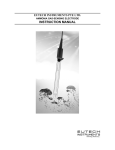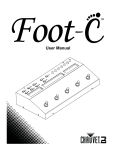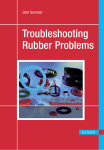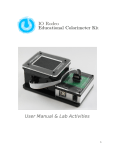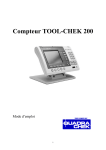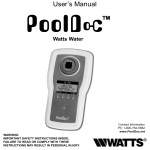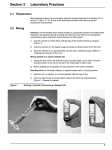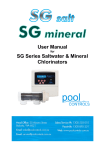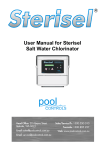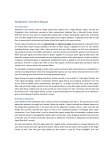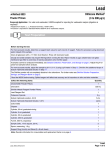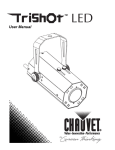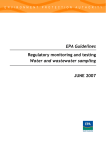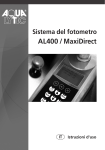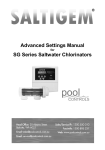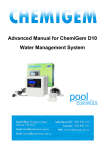Download POCKET COLORIMETER™ II ANALYSIS SYSTEMS
Transcript
59572-88 POCKET COLORIMETER™ II ANALYSIS SYSTEMS INSTRUCTION MANUAL Ammonia Monochloramine © Hach Company, 2006. All rights reserved. Printed in the U.S.A. te/dk 12/06 3ed Important Note This manual is intended for use with the following Pocket Colorimeter™ II instruments: Ammonia Cat. No. 59530-40 Monochloramine Cat. No. 59530-14 The Pocket Colorimeter™ II instruments listed above are not interchangeable. 1—2 Table of Contents Safety Precautions ............................................................................................... 1—7 Laboratory Safety ............................................................................................... 1—7 Use of Hazard Information................................................................................ 1—7 Precautionary Labels.......................................................................................... 1—8 Specifications ......................................................................................................... 1—9 Instrument Keys and Display .......................................................................... 1—13 Instrument Cap Cord ......................................................................................... 1—14 Ammonia, Nitrogen ........................................................................................... 1—17 Measuring Hints ............................................................................................... 1—17 Sampling and Storage...................................................................................... 1—25 Accuracy Check ................................................................................................ 1—25 Method Performance........................................................................................ 1—26 Standard Calibration Adjust Method ............................................................. 1—26 Interferences...................................................................................................... 1—27 Summary of Method ........................................................................................ 1—29 Reagents and Apparatus.................................................................................. 1—29 1—3 Table of Contents, continued Chloramine (Mono) ............................................................................................1—33 Measuring Hints ................................................................................................1—33 Sampling and Storage ......................................................................................1—38 Accuracy Check.................................................................................................1—38 Method Performance ........................................................................................1—40 Standard Calibration Adjust Method..............................................................1—41 Interferences ......................................................................................................1—41 Summary of Method.........................................................................................1—46 Replacement Parts.............................................................................................1—46 Instrument Operation ..........................................................................................2—3 Key Functions......................................................................................................2—3 Menu Selections ..................................................................................................2—4 Switching Ranges................................................................................................2—4 Setting the Time ..................................................................................................2—4 Recalling Stored Measurements ........................................................................2—5 Battery Installation .............................................................................................2—6 Error Codes ..............................................................................................................2—9 Error Messages ....................................................................................................2—9 Standard Calibration Adjust ...........................................................................2—13 1—4 Table of Contents, continued User-Entered Calibration ................................................................................ 2—15 Overview............................................................................................................ 2—15 Calibration Procedure Using Prepared Standards ........................................ 2—17 Entering a Predetermined Calibration Curve ................................................ 2—20 Editing a User-entered or Factory Calibration Curve .................................. 2—22 Exiting the Calibration Routine...................................................................... 2—24 Deleting Calibration Points ............................................................................. 2—24 Retrieving the Factory Calibration................................................................. 2—25 Maximum/Minimum Displayed Value........................................................... 2—26 Certification .......................................................................................................... 2—29 How to Order ........................................................................................................ 2—35 Repair Service ...................................................................................................... 2—37 Warranty ................................................................................................................ 2—38 1—5 1—6 Safety Precautions Please read this entire manual before unpacking, setting up, or operating this instrument. Pay particular attention to all danger and caution statements. Failure to do so could result in serious injury to the operator or damage to the equipment. To ensure the protection provided by this equipment is not impaired, do not use or install this equipment in any manner other than that which is specified in this manual. Laboratory Safety As part of good laboratory practice, please familiarize yourself with the reagents used in these procedures. Read all product labels and the material safety data sheets (MSDS) before using them. It is always good practice to wear safety glasses when handling chemicals. Follow instructions carefully. Rinse thoroughly if contact occurs. If you have questions about reagents or procedures, please contact the manufacturer or distributor. Use of Hazard Information If multiple hazards exist, this manual will use the signal word (Danger, Caution, Note) corresponding to the greatest hazard. 1—7 Safety Precautions, continued DANGER Indicates a potentially or imminently hazardous situation which, if not avoided, could result in death or serious injury. CAUTION Indicates a potentially hazardous situation that may result in minor or moderate injury. NOTE Information that requires special emphasis. Precautionary Labels Please pay particular attention to labels and tags attached to the instrument. Personal injury or damage to the instrument could occur if not observed. This symbol, if noted on the instrument, references the instruction manual for operational and/or safety information. 1—8 Specifications Lamp: Light emitting diode (LED) Detector: Silicon photodiode Photometric Precision: ± 0.0015 Abs Filter bandwidth: 15 nm Wavelength: 655 nm Absorbance range: 0–2.5 Abs Dimensions: 3.2 x 6.1 x 15.2 cm (1.25 x 2.4 x 6 inches) Weight: 0.2 kg (0.43 lbs) Sample cells: 25 mm (10 mL), 1 cm (10 mL) Operating conditions: 0 to 50 °C (32 to 122 °F); 0 to 90% relative humidity (noncondensing) Power supply: Four AAA alkaline batteries; approximate life is 2000 tests* * Backlight usage will decrease battery life. 1—9 1—10 OPERATION DANGER Handling chemical samples, standards, and reagents can be dangerous. Review the necessary Material Safety Data Sheets and become familiar with all safety procedures before handling any chemicals. DANGER La manipulation des échantillons chimiques, étalons et réactifs peut être dangereuse. Lire les Fiches de Données de Sécurité des Produits (FDSP) et se familiariser avec toutes les procédures de sécurité avant de manipuler tous les produits chimiques. PELIGRO La manipulación de muestras químicas, estándares y reactivos puede ser peligrosa. Revise las fichas de seguridad de materiales y familiarícese con los procedimientos de seguridad antes de manipular productos químicos. GEFAHR Das Arbeiten mit chemischen Proben, Standards und Reagenzien ist mit Gefahren verbunden. Es wird dem Benutzer dieser Produkte empfohlen, sich vor der Arbeit mit sicheren Verfahrensweisen und dem richtigen Gebrauch der Chemikalien vertraut zu machen und alle entsprechenden Materialsicherheitsdatenblätter aufmerksam zu lesen. PERIGO A manipulação de amostras, padrões e reagentes químicos pode ser perigosa. Reveja a folha dos dados de segurança do material e familiarize-se com todos os procedimentos de segurança antes de manipular quaisquer produtos químicos. PERICOLO La manipolazione di campioni, standard e reattivi chimici può essere pericolosa. La preghiamo di prendere conoscenza delle Schede Techniche necessarie legate alla Sicurezza dei Materiali e di abituarsi con tutte le procedure di sicurezza prima di manipolare ogni prodotto chimico. 1—11 1—12 Instrument Keys and Display Item Description 1 POWER/BACKLIGHT 2 ZERO/SCROLL 3 MENU 4 Numeric Display 5 Range Indicator 6 Range Indicator 7 Menu Indicator 8 Calibration Adjusted Indicator 9 Battery Low Indicator 10 READ/ENTER 1—13 Key Key Key Key Instrument Cap Cord The instrument cap for the Pocket Colorimeter™ II doubles as a light shield. Accurate measurements cannot be obtained unless the sample or blank is covered with the cap. Use the instrument cap cord to secure the cap to the body of the colorimeter and prevent loss of the cap. See Figure 1 on page 1—15. 1. Loop the instrument cap cord through the ring on the cap. 2. Remove the battery compartment cover. Press the knotted end of the cord into the hole indicated by the arrow. 3. Slide the cord into the slot on the battery compartment cover. Snap the cover into place. 1—14 Instrument Cap Cord, continued Figure 1 Attaching the Instrument Cap Cord 1—15 1—16 Ammonia, Nitrogen (0.01 to 0.80 mg/L NH3–N) Method 8155 For water, wastewater, and seawater Salicylate Method* Measuring Hints • A green color will develop if ammonia nitrogen is present. • Wipe the cells before inserting into the sample cell compartment. Note: The Pocket Colorimeter™ II is designed to measure solutions contained in sample cells. DO NOT dip the meter in the sample or pour the sample directly into the cell holder. * Adapted from Clin. Chim. Acta, 14: 403 (1996). 1—17 Ammonia, Nitrogen, continued Table 1 Recommended Sample Volumes Expected Concentration (mg/L NH3–N) Sample Volume (mL) 0.01–0.80 0.01–2.00 No dilution necessary. Use 10.0 mL directly in step 3. 10.0 0.01–4.00 5.0 0.01–8.00 2.5 0.01–20.00 1.0 1—18 Ammonia, Nitrogen, continued 1. Fill a 25-mL mixing graduated cylinder with the appropriate sample volume from Table 1. 2. Dilute to 25 mL with ammonia-free deionized water. Stopper and invert three times to mix. 1—19 3. Fill a 10-mL sample cell with 10 mL of sample from the graduated cylinder. This will become the prepared sample. Ammonia, Nitrogen, continued HRS MIN SEC 4. Fill a second 10-mL cell with 10 mL of ammoniafree deionized water. This will become the blank. 5. Add the contents of one Ammonia Salicylate Powder Pillow to each cell. Cap and shake to mix. 1—20 6. Wait 3 minutes. Ammonia, Nitrogen, continued HRS MIN SEC 7. Add the contents of one Ammonia Cyanurate Powder Pillow to each cell. Cap and shake to dissolve. 8. Wait 15 minutes. 1—21 9. After 15 minutes, invert both cells a few times to mix. Ammonia, Nitrogen, continued 10. Press the POWER key to turn the meter on. The arrow should indicate mg/L NH3–N. Note: See page 2—4 for 11. Place the yellowcolored blank in the cell holder. information on selecting the correct range channel. 1—22 12. Cover the blank with the instrument cap. Ammonia, Nitrogen, continued 13. Press ZERO/SCROLL. The display will show “- - -” then “0.00”. Remove the blank from the cell holder. 14. Place the prepared sample in the cell holder. Cover the sample cell with the instrument cap. 1—23 15. Press READ/ENTER. The display will show “- - -”, followed by results in mg/L ammonia as nitrogen (NH3–N). Ammonia, Nitrogen, continued See Table 2 16. Multiply the result from step 15 by the appropriate factor from Table 2 if a dilution was used in steps 1-2. Note: Results may be expressed as mg/L ammonia (NH3) or mg/L ammonium (NH4+) by multiplying the NH3–N result by 1.22 or 1.29, respectively. Table 2 Multiplication Factors mL Used in Step 1 Multiplier 10.0 2.5 5.0 5.0 2.5 10.0 1.0 25.0 1—24 Ammonia, Nitrogen, continued Sampling and Storage Collect samples in clean glass or plastic bottles. If chlorine is present, add one drop of 0.1 N Sodium Thiosulfate for each 0.3 mg/L Cl2 in a 1-liter sample. Preserve the sample by reducing the pH to 2 or less with sulfuric acid (at least 2 mL). Store at 4 °C (39 °F) or less. Preserved samples may be stored up to 28 days. Warm samples to room temperature. Neutralize with 5.0 N Sodium Hydroxide before analysis. Correct the test result for volume additions by multiplying by final volume (original volume plus additions) and dividing by original volume. Accuracy Check Standard Additions Method 1. Measure 25 mL of sample into each of three 25-mL mixing cylinders. 2. Use a TenSette® pipet to add 0.2, 0.4, and 0.6 mL of Ammonia Nitrogen Standard, 10 mg/L as NH3–N to the three samples, respectively. Mix well. 3. Analyze a 10-mL portion of each solution as described in the procedure. The ammonia nitrogen concentration should increase 0.08 mg/L for each 0.2 mL of standard added (using the procedure without any sample dilution). 1—25 Ammonia, Nitrogen, continued Standard Solution Method Prepare a 0.60 mg/L NH3–N standard by pipetting 6.0 mL of a 10 mg/L Ammonia Nitrogen Standard into a 100-mL volumetric flask. Dilute to 100 mL with ammonia-free water. Use 10 mL of this 0.60 mg/L ammonia nitrogen standard directly in step 3 of the procedure. Perform the procedure as described. Method Performance Precision Typical Precision (95% Confidence Interval) = 0.60 ± 0.05 mg/L NH3–N Estimated Detection Limit EDL = 0.01 mg/L NH3–N Standard Calibration Adjust Method To perform a standard calibration adjustment using the 0.60 mg/L ammonia– nitrogen standard or using an alternative concentration, see Standard Calibration Adjust on page 2—13. 1—26 Ammonia, Nitrogen, continued Interferences The following ions may interfere when present in concentrations exceeding those listed below: Calcium 1000 mg/L as CaCO3 Magnesium 6000 mg/L as CaCO3 Nitrite 12 mg/L as NO2––N Nitrate 100 mg/L as NO3––N Orthophosphate 100 mg/L as PO43––P Sulfate 300 mg/L as SO42– • Sulfide will intensify the color. Eliminate sulfide interference as follows: a. Measure about 350 mL of sample in a 500-mL Erlenmeyer flask. b. Add the contents of one Sulfide Inhibitor Reagent Powder Pillow. Swirl to mix. c. Filter the sample through a folded filter paper. d. Use the filtered solution as the sample in step 1 of the procedure. 1—27 Ammonia, Nitrogen, continued • Iron interferes with the test. Eliminate iron interference as follows: a. Determine the amount of iron in the sample using a total iron analysis. b. Add the same amount of iron to the deionized water used in the procedure for the blank. The interference from iron is successfully blanked. Extremely acidic or alkaline samples should be adjusted to approximately pH 7. Use 1.0 N Sodium Hydroxide Standard Solution for acidic samples or 1.0 N Sulfuric Acid Standard Solution for basic samples. Less common interferences such as hydrazine and glycine will cause intensified colors in the prepared sample. Turbidity and sample color will give erroneous high values. Samples with severe interferences require distillation. Albuminoid nitrogen samples also require distillation. Hach recommends the distillation procedure using the Hach General Purpose Distillation Set. See Optional Apparatus on page 1—31. 1—28 Ammonia, Nitrogen, continued Summary of Method Ammonia compounds combine with chlorine to form monochloramine. Monochloramine reacts with salicylate to form 5-aminosalicylate. The 5-aminosalicylate is oxidized in the presence of a sodium nitroprusside catalyst to form a blue-colored compound. The blue color is masked by the yellow color from the excess reagent present to give a final green-colored solution. Reagents and Apparatus Required Reagents and Apparatus (Using Powder Pillows) Description Units Cat. No. Ammonia Nitrogen Reagent Set, 10-mL sample (100 tests and blanks) ........................................................ 26680-00 Includes: (2) Ammonia Cyanurate Reagent Powder Pillows (2) Ammonia Salicylate Powder Pillows Cylinder, graduated, mixing, 25 mL...............1 ........................... each.........20886-40 1—29 Ammonia, Nitrogen, continued Optional Reagents Description Units Cat. No. Nitrogen Ammonia Standard Solution (NIST), 10 mg/L as (NH3–N) .................................................................. 500 mL ........ 153-49 Nitrogen Ammonia Voluette™ Ampules (NIST), 50 mg/L as (NH3–N), 10 mL ...................................................... 16/pkg .....14791-10 Sodium Hydroxide Standard Solution, 1.0 N ...................100 mL MDB .......1045-32 Sodium Hydroxide Standard Solution, 5.0 N ...............................59 mL ...... 2450-26 Sodium Thiosulfate Standard Solution, 0.1 N ..................100 mL MDB ........ 323-32 Sulfide Inhibitor Reagent Powder Pillows..................................100/pkg .......2418-99 Sulfuric Acid, concentrated, ACS ................................................ 500 mL ........ 979-49 Sulfuric Acid Standard Solution, 1.0 N .............................100 mL MDB .......1270-32 Wastewater Standard, mixed parameter, influent, QC, (Ammonia, Nitrate, Phosphate, COD, Sulfate, TOC)..................................................................... 500 mL .... 28331-49 Wastewater Standard, mixed parameter, effluent, QC, (Ammonia, Nitrate, Phosphate, COD, Sulfate, TOC)..................................................................... 500 mL .... 28332-49 Water, deionized .................................................................................... 4 L ........ 272-56 1—30 Ammonia, Nitrogen, continued Optional Apparatus Description Units Cat. No. Cylinder, graduated, polypropylene, 500 mL .................................. each ....... 1081-49 Distillation Heater and Support Apparatus, 115 V ......................... each .....22744-00 Distillation Heater and Support Apparatus, 230 V......................... each .....22744-02 Distillation Set, General Purpose ...................................................... each .....22653-00 Filter Paper, folded, 12.5 cm........................................................100/box .......1894-57 Flask, Erlenmeyer, polypropylene, 500 mL ..................................... each ....... 1082-49 Flask, volumetric, Class A, 100 mL................................................... each .....14574-42 Flask, volumetric, Class A, 1000 mL ................................................ each .....14574-53 Funnel, polypropylene, 65 mm. ........................................................ each ....... 1083-67 sension™1 Basic Portable pH Meter, with electrode ..................... each ..... 51700-10 Pipet Filler, safety bulb ...................................................................... each .....14651-00 Pipet, Tensette®, 0.1 to 1.0 ml ........................................................... each ..... 19700-01 Pipet Tips, for 19700-01 Tensette® Pipet ...................................... 50/pkg .....21856-96 Pipet volumetric, Class A, 4.0 mL..................................................... each .....14515-04 Pipet volumetric, Class A, 8.0 mL..................................................... each .....14515-08 Thermometer, -10 to 110 °C ............................................................... each ....... 1877-01 1—31 Ammonia, Nitrogen, continued Replacement Parts Description Units Cat. No. Batteries, AAA, alkaline ...................................................................4/pkg .... 46743-00 Instrument Cap/light shield................................................................each .... 59548-00 Instruction Manual, Ammonia/Monochloramine ...........................each .... 59572-88 Sample Cell, 10-mL, with cap ..........................................................6/pkg .... 24276-06 1—32 Chloramine (Mono) (0.04 to 4.50 mg/L as Cl2) Method 10171 For chloraminated drinking water and chlorinated wastewater Indophenol Method* Measuring Hints • Analyze samples immediately. Do not preserve for later analysis. Note: The Pocket Colorimeter™ II is designed to measure solutions contained in sample cells. DO NOT dip the meter in the sample or pour the sample directly into the cell holder. * U.S. Patent No. 6,315,950 1—33 Chloramine (Mono), continued 1. Press the POWER key to turn the meter on. The arrow should indicate mg/L Cl2. Note: See page 2—4 for information on selecting the correct range channel. 2. Fill the 10-mL/1-cm cell to the 10 mL line with sample. Note: Samples must be analyzed immediately and cannot be preserved for later analysis. 1—34 3. Remove the instrument cap and place the cell in the cell holder with the triangle facing the keypad. Note: Wipe excess liquid and fingerprints from the sample cells. Chloramine (Mono), continued 4. Cover the cell with the instrument cap. 5. Press ZERO/SCROLL. The display will show “- - - -” then “0.00”. Remove the blank from the cell holder. 1—35 6. Fill another 10-mL/1-cm cell to the 10-mL line with sample. Add the contents of one Monochlor-F Powder Pillow to the sample cell. Chloramine (Mono), continued 10 m L 5 m L 7. Cap the cell and shake for 20 seconds. 8. Wait five minutes. Place the prepared sample in the cell holder. Note: Samples colder than 18 °C will require additional reaction time. See Table 3 on page 1—45 for correct times. Note: Wipe liquid off sample cells. 1—36 9. Cover the cell with the instrument cap. Chloramine (Mono), continued 10. Press READ/ENTER. The display will show “- - -” , followed by results in mg/L chlorine. 1—37 Chloramine (Mono), continued Sampling and Storage Analyze samples for monochloramine immediately after collection. If sampling with the sample cell, rinse the cell several times with the sample, then carefully fill to the 10-mL mark. If sampling from a tap, let the water flow for at least 5 minutes. Let the container overflow with the sample several times, then cap the container so there is no headspace (air) above the sample. Accuracy Check Standard Solutions Method Standard solutions for monochloramine are difficult and time-consuming to prepare. Errors can occur if attention to detail is not addressed during preparation of the standards. Hach Company prepares the calibration curve under rigorous analytical laboratory conditions. Hach recommends using the factory calibration. A user calibration or a user-prepared monochloramine standard may be required by a regulatory official or agency. Two options are available on the Pocket Colorimeter™ II to meet this requirement. A monochloramine standard may be prepared and used to validate the calibration curve using the Standard Calibration Adjust feature (see page 2—13 for more 1—38 Chloramine (Mono), continued information.) In addition, a user-generated calibration curve can be made and programmed into the Pocket Colorimeter™ II. See Calibration Procedure Using Prepared Standards on page 2—17 for more information about preparing a full calibration curve. Standard Solution Preparation 1. Prepare the following monochloramine standard fresh before use. 2. Add the contents of one pillow Buffer Powder, pH 8.3 to about 50-mL of Organic Free Water in a clean 100-mL Class A volumetric flask. Swirl to dissolve the powder. 3. Using a Class A volumetric pipet, transfer 2.00 mL of Ammonia Nitrogen Standard Solution, 100 mg/L as NH3–N into the flask. 4. Dilute to volume with Organic Free Water, cap and mix thoroughly. This is a 2.00 mg/L buffered ammonia standard. 5. Pipet 30.00 mL of the buffered ammonia standard into a clean 100-mL beaker with a stir bar. 6. Obtain a recent lot of Chlorine Solution Ampules, 50 –70 mg/L, and note the actual Free Chlorine concentration for this lot. 1—39 Chloramine (Mono), continued 7. Calculate the amount of Chlorine Solution to be added to the ammonia standard using the following equation: 273 mL chlorine solution required = --------------------------------------------------------------free chlorine concentration 8. Open an ampule and use a glass Mohr pipet to add the calculated amount of Chlorine Solution slowly to the ammonia standard, while mixing at medium speed on a stir-plate. 9. Allow the monochloramine solution to mix for 1 minute after all the Chlorine Solution is added. 10. Quantitatively transfer the monochloramine solution to a clean 100-mL Class A volumetric flask. Dilute to the mark with Organic Free Water, cap, and mix thoroughly. This is a nominal 2.7 mg/L (as Cl2) monochloramine standard. Use this standard within 1 hour of preparation. Method Performance Precision Typical Precision (95% Confidence Interval) = 2.25 ± 0.04 mg/L as Cl2 1—40 Chloramine (Mono), continued Estimated Detection Limit EDL = 0.04 mg/L as Cl2 Standard Calibration Adjust Method To perform a standard calibration adjustment using the Standard Solution prepared above or using an alternative concentration, see Standard Calibration Adjust on page 2—13. Interferences The following have been tested for interference and found not to interfere up to the indicated levels (in mg/L): Table 1 Substances that Do Not Interfere Substance Maximum Level Tested Alanine 1 mg/L as N Aluminum 10 mg/L Bromide 100 mg/L 1—41 Chloramine (Mono), continued Table 1 Substances that Do Not Interfere (Continued) Substance Maximum Level Tested Bromine 15 mg/L Calcium 1000 mg/L CaCO3 Chloride 18,000 mg/L Chlorine Dioxide Chromium 5 mg/L ClO2 3+ 5 mg/L Copper 10 mg/L Cyanide 10 mg/L Free Chlorine 10 mg/L as Cl2 Glycine 1 mg/L as N 2+ 10 mg/L Iron 3+ 10 mg/L Lead 10 mg/L Iron 1—42 Chloramine (Mono), continued Table 1 Substances that Do Not Interfere (Continued) Substance Maximum Level Tested Nitrate 100 mg/L as N Nitrite 50 mg/L as N Phosphate 100 mg/L PO4 Silica 100 mg/L SiO2 Silver 10 mg/L Sulfates 2600 mg/L Sulfite 50 mg/L SO3 Tyrosine 1 mg/L as N Urea 10 mg/L as N Zinc 5 mg/L 1—43 Chloramine (Mono), continued The following may interfere when present at concentrations greater than listed: Table 2 Substances that May Interfere Interfering Substance and Positive or Negative Effect Interference Level Recommended Treatment Above 400 mg/L CaCO3 Add 5 drops Rochelle Salt solution before testing Manganese 7+(−) Above 3 mg/L — Ozone(−) Above 1 mg/L NA Usually doesn’t co-exist with monochloramine. Sulfide(+) Turns rust colored if present NA Usually doesn’t co-exist with monochloramine. Above 0.5 mg/L — Magnesium(+) Thiocyanate(−) 1—44 Chloramine (Mono), continued Color development time varies inversely with the temperature of the sample. Use this table to determine the minimum color development time for a sample. Table 3 Color Development Time Based on Sample Temperature Sample Temperature Time minutes °C °F 5 40 10 7 42 9 9 48 8 10 50 8 12 54 7 14 58 7 16 61 6 18 68 4 20 73 3 23 75 2½ 1—45 Chloramine (Mono), continued Table 3 Color Development Time Based on Sample Temperature (Continued) Sample Temperature °C °F 25 77 Time minutes 2 Summary of Method In the presence of a cyanoferrate catalyst, monochloramine in the sample reacts with a substituted phenol to form an intermediate monoimine compound. The intermediate couples with excess substituted phenol to form a green-colored indophenol, which is proportional to the amount of monochloramine present in the sample. Replacement Parts Required Reagents Description Unit Cat. No. Monochlor-F Reagent Pillows ...................................................... 50/pkg .... 28022-46 1—46 Chloramine (Mono), continued Required Apparatus (Using AccuVac® Ampuls) Description Unit Cat. No. Sample Cell, 1-cm/10 mL................................................................. 2/pkg .....48643-02 Clippers (Shears).................................................................................. each .....23694-00 Optional Reagents Rochelle Salt Solution ...............................................................29 mL DB .......1725-33 Organic Free Water ........................................................................ 500 mL .....26415-49 Buffer Powder Pillows .................................................................... 25/pkg ......... 898-68 Nitrogen Ammonia Standard Solution 100 mg/L as NH3–N ................................................................... 500 mL .....24065-49 Chlorine Solution Voluette Ampule.............................................. 16/pkg .....14268-10 Optional Apparatus Description Unit Cat. No. Beaker, 100-mL.................................................................................... each ...... 500-42H Flask, Volumetric, Class A, 100-mL.................................................. each .....14574-42 1—47 1—48 Section 2 Instrument Manual 2—1 2—2 Instrument Operation Key Functions Key Description Function POWER On/Off/Backlight To turn on the backlight, turn on the instrument, then press and hold the power key until the backlight turns on. Press and hold again to turn off the backlight. This key functions the same in all instrument modes and ranges. ZERO/SCROLL In measurement mode, sets the instrument to zero. In menu mode, scrolls through menu options. Also scrolls numbers when entering or editing a value. READ/ENTER In measurement mode, initiates sample measurement. In menu mode, selects a menu option. When entering numbers, moves one space to the right and executes the function when the entry is complete. 2—3 Instrument Operation, continued Key Description Function MENU Enter/Exit the menu mode Press and hold for approximately 5 seconds to enter user-entered method mode. Menu Selections Press the MENU key to access the menu selections. Switching Ranges 1. Press the MENU key. The display will show “SEL”. A flashing arrow indicates the current range. 2. Press the READ/ENTER key to toggle between ranges. 3. Press MENU again to accept and exit back to the measurement screen. Setting the Time 1. Press the MENU key, then press the ZERO/SCROLL key until the display shows a time in the “00:00” format. 2—4 Instrument Operation, continued 2. Press READ/ENTER. The digit to be edited will flash. 3. Use the ZERO/SCROLL key to change the entry, then press READ/ENTER to accept and advance to the next digit. The time is entered in 24-hour format. Recalling Stored Measurements 1. Press the MENU key, then press the ZERO/SCROLL key until the display shows RCL. The instrument automatically stores the last 10 measurements. 2. In RCL, press READ/ENTER to recall the stored measurements, beginning with the most recent measurement taken. The meter stores the measurement number as 01 (most recent) through 10 (oldest), the time the measurement was taken, and the measurement value. The ZERO/SCROLL key allows for selection of a specific measurement by number. The READ/ENTER key scrolls through all stored data points. 2—5 Instrument Operation, continued Battery Installation Figure 1 on page 2—7 provides an exploded view of battery installation. 1. Unhook the latch and remove the battery compartment cover. The polarities are shown on the battery holder. 2. Place the four batteries provided with the instrument in the holder as indicated and replace the battery compartment cover. The display will show the software version number (e.g., “P 1.6”) after correct battery installation. When replacing discharged batteries, always replace the complete set of four alkaline batteries. Rechargeable batteries are not recommended and cannot be recharged in the instrument. Note: The Low Battery icon will appear on the display when the batteries have 10% battery life remaining. The battery icon will flash when the batteries are too low to complete measurements. See Instrument Keys and Display on page 1—13. 2—6 Instrument Operation, continued Figure 1 Battery Installation 2—7 2—8 Error Codes When the instrument cannot perform the function initiated by the operator, an error message will appear in the display. Refer to the appropriate message information below to determine what the problem is and how it can be corrected. Resolve error messages in the order that they appear on the display. Service Centers are listed in page 2—37. Error Messages 1. E-0 No Zero (User mode) Error occurs when trying to read a standard in the user calibration mode before setting the meter to zero. • Zero the instrument on an appropriate blank. 2. E-1 Ambient Light Error There is too much light present to take a valid measurement. • • Verify instrument cap is correctly seated. If the problem persists, contact a Service Center (page 2—37). 2—9 Error Codes, continued 3. E-2 LED Error The LED (light source) is out of regulation. • • Replace batteries. Verify LED lights up (inside the cell holder) when the READ/ENTER or ZERO/SCROLL key is pressed. • If the problem persists, contact a Service Center (page 2—37). Note: When an E-1 or E-2 error occurs on a measurement, the display will show “_.__”. (The decimal place is determined by the chemistry.) If the E-1 or E-2 error occurs while zeroing the meter, the meter will require the user to re-zero. 4. E-3 Standard Adjust Error The value obtained on the prepared standard exceeds the adjustment limits allowed for the standard concentration, or the concentration of the standard is outside the concentration range allowed for standard calibration adjust. • • • Prepare the standard and rerun according to the procedure. Prepare a standard at or near the recommended concentrations given in the procedure. Verify that the concentration of the standard has been entered correctly. 2—10 Error Codes, continued • If the problem persists, contact a Service Center (page 2—37). 5. E-6 Abs Error (User mode) Indicates that the absorbance value is invalid, or indicates an attempt to make a curve with less than two points. • • Enter or measure the absorbance value again. If the problem persists, contact a Service Center (page 2—37). 6. E-7 Standard Value Error (User mode) Standard concentration is equal to another standard concentration that is already entered. • • Enter the correct standard concentration. If the problem persists, contact a Service Center (page 2—37). 7. E-9 Flash Error The meter is unable to save data. • If the problem persists, contact a Service Center (page 2—37). 2—11 Error Codes, continued 8. Underrange—flashing number below stated test range • Verify instrument cap is correctly seated. • Check zero by measuring a blank. If error recurs, re-zero the instrument. • If the problem persists, contact a Service Center (page 2—37). Note: See Maximum/Minimum Displayed Value on page 2—26 for more information. 9. Overrange—flashing number above stated test range Note: Flashing value will be 10% over the upper test limit. • • Check for light blockage. Dilute and retest sample. Note: See Maximum/Minimum Displayed Value on page 2—26 for more information. 2—12 Standard Calibration Adjust The Pocket Colorimeter™ II instrument is factory-calibrated and ready for use without user calibration. Use of the factory calibration is recommended unless the user is required to generate a calibration. The Standard Calibration Adjust can be used to meet regulatory requirements. This feature allows the factory default calibration curve to be adjusted with a known standard. Use the standard described in the procedure. 1. 2. 3. 4. 5. Place a blank in the meter (in measurement mode). Press ZERO/SCROLL. Place the reacted standard in the meter. Press READ/ENTER. Press MENU, then press ZERO/SCROLL until the display shows “SCA”. Press READ/ENTER to display the standard calibration adjust value. Press READ/ENTER to adjust the curve to the displayed value. The meter will return to the measurement mode and the Calibration Adjusted icon will appear in the display window. If an alternate concentration is used, or if a standard concentration is not given: 6. Repeat steps 1–4. 2—13 Standard Calibration Adjust, continued 7. Press ZERO/SCROLL to access the Edit function, then press READ/ENTER to begin editing. The digit to be edited will flash. Use the ZERO/SCROLL key to change the entry, then press READ/ENTER to accept and advance to the next digit. When the last digit is entered, press READ/ENTER and the meter will adjust the curve to the value entered. The meter will return to measurement mode and the Calibration Adjusted icon will appear in the display window. To turn off Standard Calibration Adjust (SCA): 1. 2. 3. 4. Press MENU. Press ZERO/SCROLL until “SCA” appears in the display. Press READ/ENTER, then press ZERO/SCROLL until “Off” appears in the display. Press READ/ENTER to turn off SCA. Note: Perform another standard calibration adjust to turn SCA on again. Note: For meters with factory-calibrated ranges or methods, Standard Calibration Adjust (SCA) will be disabled when a user-entered method is programmed into the meter. To turn SCA back on, restore the meter to factory default calibration. See Retrieving the Factory Calibration on page 2—25. 2—14 User-Entered Calibration Overview The Pocket Colorimeter™ II will accept a user-prepared calibration curve. The curve can extend from 0 to 2.5 absorbance. A user-prepared calibration curve may be entered into any channel that does not contain a factory-programmed curve. These channels are labeled “abs” on instruments having a single factory calibration or are labeled “1” and “2” on the uncalibrated single wavelength instruments. Any chemistry that can be run at the instrument wavelength may be user-entered in these channels. Using prepared standard solutions that cover the range of interest, the meter generates a calibration curve by calculating the straight-line segments between each standard entered. A calibration curve may be entered using the keypad. Factory-entered calibration curves may also be recalculated or adjusted using the same procedure. To enter the user-entered calibration mode, press the MENU key and hold it down until the display shows “USER” (about 5 seconds), followed by “CAL”. Press ZERO/SCROLL to scroll through the options. Note: If the meter does not display USER followed by CAL after pressing the MENU key, the factory calibration cannot be modified on this channel. 2—15 User-Entered Calibration, continued • CAL—Used to enter and edit standard values and measure absorbance values, or review the existing calibration. • Edit—Used to enter and edit standard values and absorbance values with the keypad or review the existing calibration. Used to enter a predetermined calibration curve. • dFL—Used to return the instrument back to the default factory calibration. User-entered calibrations are stored upon exit from the calibration or edit modes. Note: To return to factory settings, following the instructions in Retrieving the Factory Calibration on page 2—25. If the instrument is shut off or loses power during data entry, all edits will be lost. Automatic shut-off in user-entered calibration entry mode is 60 minutes. CAL and Edit Submenus In CAL mode, standard values are entered and absorbance values are measured. In Edit mode, standard and absorbance values are entered. • • To select CAL from the User menu, press READ/ENTER. To select Edit from the User menu, press ZERO/SCROLL and READ/ENTER. 2—16 User-Entered Calibration, continued • Once in the CAL or Edit option, press the READ/ENTER key to navigate through each option. Note: Press ZERO/SCROLL to quickly scroll through each option. Calibration Procedure Using Prepared Standards Note: Deionized water or a reagent blank can be used to zero during the calibration procedure. Calibrations generated with deionized water as the zero will give less accurate results if the reagent blank is significantly more turbid or colored than deionized water. Use the deionized water or the reagent blank as the zero concentration point (S0) in the following calibration procedure. 1. Turn on the instrument and select the range to be calibrated. An arrow at the top of the display will point to the selected range. To change ranges, press the MENU key, then use the READ/ENTER key to toggle between ranges 1 and 2. Press MENU again to return to measurement mode. 2. Follow the procedure for the chemical method to be calibrated. Prepare a reagent blank (if needed) and a standard solution. Allow the color to develop fully. 2—17 User-Entered Calibration, continued 3. Insert the reagent blank or deionized water into the meter and cover with the cap. Press the ZERO/SCROLL key. The meter will display “- - - -”, followed by “0.000”. This initializes (zeroes) the meter. 4. Press the MENU key and hold it down until the display shows “USER”, followed by “CAL”. Press READ/ENTER to enter the calibration mode. 5. In factory-calibrated meters, S0 will appear in the display. Note: When recalibrating a factory-calibrated meter or range, RES (resolution) cannot be changed. 6. In uncalibrated meters or meters with ranges labeled Abs, “RES” will appear. Press ZERO/SCROLL to review the current resolution (decimal placement). Press ZERO/SCROLL again to accept the current resolution. To change the resolution, press READ/ENTER, then ZERO/SCROLL to change the resolution. Press READ/ENTER to accept the new resolution. “S0” will appear on the display. 7. Press the READ/ENTER key again, then enter the blank value. Note: Press the READ/ENTER key to move from digit to digit. Use the ZERO/SCROLL key to change the number. 8. After completing entry of the blank value, press the READ/ENTER key. The display will show “A0”. 2—18 User-Entered Calibration, continued 9. Insert the reagent blank or deionized water into the cell holder. Cover the blank with the instrument cap. 10. Press the READ/ENTER key. The meter will measure and display the absorbance value for “S0”. 11. Remove the sample blank. Press the ZERO/SCROLL key. “S1” will appear. Press the READ/ENTER key, then enter the first standard value. Note: Press the READ/ENTER key to move from digit to digit. Use the ZERO/SCROLL key to change the number. 12. After completing entry of the first standard value, press the READ/ENTER key. The display will show “A1”. 13. Insert the first reacted standard solution into the cell holder. Cover the prepared standard with the instrument cap. 14. Press the READ/ENTER key. The meter will measure and display the absorbance value for S1. 15. The calibration is complete with two points. If additional standards are required, press ZERO/SCROLL until “Add” appears on the display. Repeat steps 11–14 to enter additional standards. 2—19 User-Entered Calibration, continued 16. Press the MENU key twice to exit and accept the changes. The instrument will use this calibration to determine the displayed concentration of future sample measurements. Entering a Predetermined Calibration Curve Note: Entering a predetermined calibration curve requires at least two data pairs. Each data pair requires a concentration value and the absorbance value for the given concentration. Up to 10 data pairs may be entered. This procedure uses the Edit mode. 1. Turn on the instrument and select the range to be calibrated. An arrow at the top of the display will point to the selected range. To change ranges, press the MENU key, then use the READ/ENTER key to toggle between ranges 1 and 2. Press MENU again to return to measurement mode. 2. Press the MENU key and hold it down until the display shows “USER”, followed by “CAL”. Press ZERO/SCROLL to scroll to EDIT. Press READ/ENTER. 3. In uncalibrated meters or in Abs range, “RES” will appear. Press ZERO/SCROLL. To change the resolution (decimal placement), press READ/ENTER. Press ZERO/SCROLL to select the new resolution, then press READ/ENTER to accept. “S0” will appear on the display. 2—20 User-Entered Calibration, continued 4. Enter the concentration value and absorbance value of the first data pair (S0, A0). 5. To enter the S0 value, press READ/ENTER. Use the ZERO/SCROLL key to select the numerical value, then press the READ/ENTER key to accept the entry and advance to the next decimal place. Repeat this sequence until the S0 concentration value is entered. 6. After editing the S0 value, press READ/ENTER to accept. “A0” will appear on the display. 7. To enter the absorbance value for S0, press the READ/ENTER key to go to entry mode. Use the ZERO/SCROLL key to select the numerical value, then press the READ/ENTER key to accept the entry and advance to the next decimal place. Repeat this sequence until the absorbance value for S0 is entered. 8. After entering A0, press READ/ENTER to accept. “S1” will appear on the display. 9. Repeat steps 5 through 8 for each standard value and absorbance value pair in the calibration curve Note: After A1 is entered, Add will appear in the display. If additional data pairs are to be entered, press READ/ENTER and continue with step 9. 2—21 User-Entered Calibration, continued 10. When all the calibration data has been entered, press MENU twice to return to the measurement mode. Editing a User-entered or Factory Calibration Curve 1. Press the MENU key and hold it down until the display shows “USER”, followed by “CAL”. Press ZERO/SCROLL until EDIT appears. Note: If the meter does not display USER followed by CAL after pressing the MENU key, the factory calibration cannot be modified on this channel. 2. Press the READ/ENTER key to enter Edit mode. In factory-calibrated meters, “S0” will appear in the display. Note: When editing a factory-calibrated meter or range, RES (resolution) cannot be changed. Note: When RES or S0 appears in the display, press ZERO/SCROLL to quickly scroll to the data to be edited. 3. In uncalibrated meters or in Abs range, “RES” will appear. Press ZERO/SCROLL to review the current resolution. Press ZERO/SCROLL again to accept the displayed resolution. To change the resolution (decimal placement), press READ/ENTER. Press ZERO/SCROLL to select the new resolution, then press READ/ENTER to accept. “S0” will appear on the display. 2—22 User-Entered Calibration, continued 4. Press READ/ENTER. The current concentration value for S0 will appear on the display. 5. To edit the S0 value, press READ/ENTER. Use the ZERO/SCROLL key to select the numerical value, then press the READ/ENTER key to accept the entry and advance to the next decimal place. Repeat this sequence until the S0 concentration value is entered. 6. After editing the S0 value, press READ/ENTER to accept. “A0” will appear on the display. 7. To edit the absorbance value for S0, press the READ/ENTER key to go to entry mode. Use the ZERO/SCROLL key to select the numerical value, then press the READ/ENTER key to accept the entry and advance to the next decimal place. Repeat this sequence until the absorbance value for S0 is entered. 8. After editing A0, press READ/ENTER to accept. “S1” will appear on the display. 9. Repeat steps 4 through 8 for each standard value and absorbance value pair in the calibration curve. 10. When all calibration data has been reviewed or edited, “ADD” will appear in the display. 2—23 User-Entered Calibration, continued 11. Press READ/ENTER to add more calibration points, or press MENU twice to return to the measurement mode. Note: When a factory calibration curve has been edited, the “calibration adjust” icon will appear in the display. Exiting the Calibration Routine Exit the calibration routine by pressing the MENU key to return to measurement mode. The instrument uses the last completed user-entered calibration or the factory calibration if no user-entered calibration has been completed. Deleting Calibration Points 1. Select the range containing user-entered calibration points. See Switching Ranges on page 2—4. 2. Press and hold the MENU key until “USER”, then “CAL” appears. Press READ/ENTER. Note: Calibration points can also be deleted in Edit mode. 3. Press ZERO/SCROLL to select the point to delete (e.g., S0 or S1 or S2). Press READ/ENTER. 2—24 User-Entered Calibration, continued 4. The left digit will flash. Press ZERO/SCROLL until “dEL” appears. (“dEL” will appear after the numeral 9.) 5. Press READ/ENTER to delete. Repeat for all points to be deleted. Note: The minimum number of valid points is two. For example, if five points have been entered, three can be deleted using this feature. 6. Press MENU to return to the measurement mode. Retrieving the Factory Calibration 1. Select the range to restore factory default calibration. See Switching Ranges on page 2—4. 2. Press and hold the MENU key until “USER”, then “CAL” appears. Note: If the meter does not display USER followed by CAL after pressing the MENU key, the factory calibration cannot be modified on this channel. 3. Press the ZERO/SCROLL key to find dFL. 4. Press the READ/ENTER key to select dFL and restore the instrument to the factory default calibration. 2—25 User-Entered Calibration, continued Note: For meters with factory-calibrated ranges or methods, Standard Calibration Adjust (SCA) will be disabled when a user-entered method is programmed into the meter. To turn SCA back on, restore the meter to factory default calibration. Maximum/Minimum Displayed Value In meters with absorbance (Abs) ranges, the maximum displayed value and minimum displayed value is related to the value of the standards entered in a user calibration. Measurements that exceed the minimum or maximum standards entered in the user calibration will return a flashing number indicating “underrange” or “overrange”. See Error Codes (page 2—12) for more information. Example 1 For a calibration with the following standards: S0=0.000 S1=1.000 Maximum Displayed Value 1.000 Minimum Displayed Value 0.000 2—26 User-Entered Calibration, continued Example 2 For a calibration with the following standards: S0=1.00 S1=2.00 S2=4.00 Maximum Displayed Value 4.00 Minimum Displayed Value 1.00 For Hach-calibrated programs, the maximum and minimum displayed values always equal the factory-calibrated values and cannot be changed. 2—27 2—28 Certification Hach Company certifies this instrument was tested thoroughly, inspected, and found to meet its published specifications when it was shipped from the factory. The Pocket Colorimeter™ II instrument has been tested and is certified as indicated to the following instrumentation standards: EMC Immunity: Per 89/ 336/ EEC EMC: EN 61326: 1998 (Electrical Equipment for measurement, control and laboratory use—EMC requirements). Supporting test records by Hach Company, certified compliance by Hach Company. Standard(s) include: IEC 1000-4-2: 1995 (EN 61000-4-2: 1995) Electro-Static Discharge Immunity (Criteria B) IEC 1000- 4- 3: 1995 (EN 61000- 4- 3: 1996) Radiated RF Electro- Magnetic Field Immunity (Criteria A) Additional Immunity Standard(s) include: ENV 50204: 1996 Radiated Electromagnetic Field from Digital Telephones 2—29 Certification, continued (Criteria A) Radio Frequency Emissions: Per 89/ 336/ EEC EMC: EN 61326: 1998 (Electrical Equipment for measurement, control and laboratory use—EMC requirements) “Class B” emission limits. Supporting test records from Hach EMC Test Facility, certified compliance by Hach Company. Additional Radio Frequency Emissions Standard(s) include: EN 55022 (CISPR 22), Class B emissions limits. Canadian Interference-causing Equipment Regulation, IECS-003, Class A: Supporting test records from Hach EMC Test Facility, certified compliance by Hach Company. This Class A digital apparatus meets all requirements of the Canadian Interference-causing Equipment Regulations. Cet appareil numérique de la classe A respecte toutes les exigences du Règlement sur le matériel brouilleur du Canada. FCC Part 15, Class “A” Limits: Supporting test records from Hach EMC Test Facility, certified compliance by Hach Company. 2—30 Certification, continued This device complies with Part 15 of the FCC Rules. Operation is subject to the following two conditions: (1) This device may not cause harmful interference, and (2) This device must accept any interference received, including interference that may cause undesired operation. Changes or modifications to this unit not expressly approved by the party responsible for compliance could void the user's authority to operate the equipment. This equipment has been tested and found to comply with the limits for a Class A digital device, pursuant to Part 15 of the FCC Rules. These limits are designed to provide reasonable protection against harmful interference when the equipment is operated in a commercial environment. This equipment generates, uses, and can radiate radio frequency energy and, if not installed and used in accordance with the instruction manual, may cause harmful interference to radio communications. Operation of this equipment in a residential area is likely to cause harmful interference, in which case the user will be required to correct the interference at his own expense. The following techniques of reducing the interference problems are applied easily. 2—31 Certification, continued 1. Remove power from the Pocket Colorimeter instrument by removing one of its batteries to verify that it is or is not the source of the interference. 2. Move the Pocket Colorimeter instrument away from the device receiving the interference. 3. Reposition the receiving antenna for the device receiving the interference. 4. Try combinations of the above. 2—32 GENERAL INFORMATION At Hach Company, customer service is an important part of every product we make. With that in mind, we have compiled the following information for your convenience. 2—33 2—34 How to Order By Telephone: 6:30 a.m. to 5:00 p.m. MST Monday through Friday (800) 227-HACH (800-227-4224) By Mail: Hach Company P.O. Box 389 Loveland, Colorado 80539-0389 U.S.A. By FAX: (970) 669-2932 (Hach Loveland) For order information by E-mail: [email protected] Information Required: • Hach account number (if available) • Purchase order number • Billing address • Catalog number • Shipping address • Brief description or model number • Your name and phone number • Quantity 2—35 How to Order, continued Technical and Customer Service (USA only) Hach Technical and Customer Service Department personnel are eager to answer questions about our products and their use and to take your orders. Specialists in analytical methods, they are happy to put their talents to work for you. Call 1-800-227-4224 or E-mail [email protected]. International Customers Hach maintains a worldwide network of dealers and distributors. To locate the representative nearest you, send E-mail to intl@hach. com or call (970) 669-3050. In Canada Hach Instrument Service Centre, Winnipeg, Manitoba, Canada Telephone: (204) 632-5598; (800) 665-7635 FAX: (204) 694-5134 2—36 Repair Service Authorization must be obtained from Hach Company before sending any items for repair. Please contact the Hach Service Center serving your location. In the United States: Hach Company 100 Dayton Avenue Ames, Iowa 50010 (800) 227-4224 (USA only) FAX: (515) 232-3835 Canada: Hach Sales & Service Canada Ltd. 1313 Border Street, Unit 34 Winnipeg, Manitoba R3H 0X4 (800) 665-7635 (Canada only) Telephone: (204) 632-5598 FAX: (204) 694-5134 E-mail: [email protected] Latin America, Caribbean, Africa, Far East, Indian Subcontinent: Hach Company World Headquarters P.O. Box 389 Loveland, Colorado 80539-0389 U.S.A. Telephone: (970) 669-3050 FAX: (970) 669-2932 E-mail: intl@hach. com. Europe, the Middle East, or Mediterranean Africa: HACH Company, c/o Dr. Bruno Lange GmbH & CO. KG Willstätterstr. 11 40549 Düsseldorf, Germany Telephone: +49/(0)211/52 88-0 FAX: +49/(0)211/52 88-134 2—37 Warranty Hach Company warrants this product to the original purchaser against any defects that are due to faulty material or workmanship for a period of two years from date of shipment. In the event that a defect is discovered during the warranty period, Hach Company agrees that, at its option, it will repair or replace the defective product or refund the purchase price, excluding original shipping and handling charges. Any product repaired or replaced under this warranty will be warranted only for the remainder of the original product warranty period. This warranty does not apply to consumable products such as chemical reagents; or consumable components of a product, such as, but not limited to, lamps and tubing. Contact Hach Company or your distributor to initiate warranty support. Products may not be returned without authorization from Hach Company. 2—38 Warranty, continued Limitations This warranty does not cover: • damage caused by acts of God, natural disaster, labor unrest, acts of war (declared or undeclared), terrorism, civil strife or acts of any governmental jurisdiction • damage caused by misuse, neglect, accident or improper application or installation • damage caused by any repair or attempted repair not authorized by Hach Company • any product not used in accordance with the instructions furnished by Hach Company • • freight charges to return merchandise to Hach Company • travel fees associated with on-site warranty repair freight charges on expedited or express shipment of warranted parts or product 2—39 Warranty, continued This warranty contains the sole express warranty made by Hach Company in connection with its products. All implied warranties, including without limitation, the warranties of merchantability and fitness for a particular purpose, are expressly disclaimed. Some states within the United States do not allow the disclaimer of implied warranties and if this is true in your state the above limitation may not apply to you. This warranty gives you specific rights, and you may also have other rights that vary from state to state. This warranty constitutes the final, complete, and exclusive statement of warranty terms and no person is authorized to make any other warranties or representations on behalf of Hach Company. Limitation of Remedies The remedies of repair, replacement or refund of purchase price as stated above are the exclusive remedies for the breach of this warranty. On the basis of strict liability or under any other legal theory, in no event shall Hach Company be liable for any incidental or consequential damages of any kind for breach of warranty or negligence. 2—40
























































































